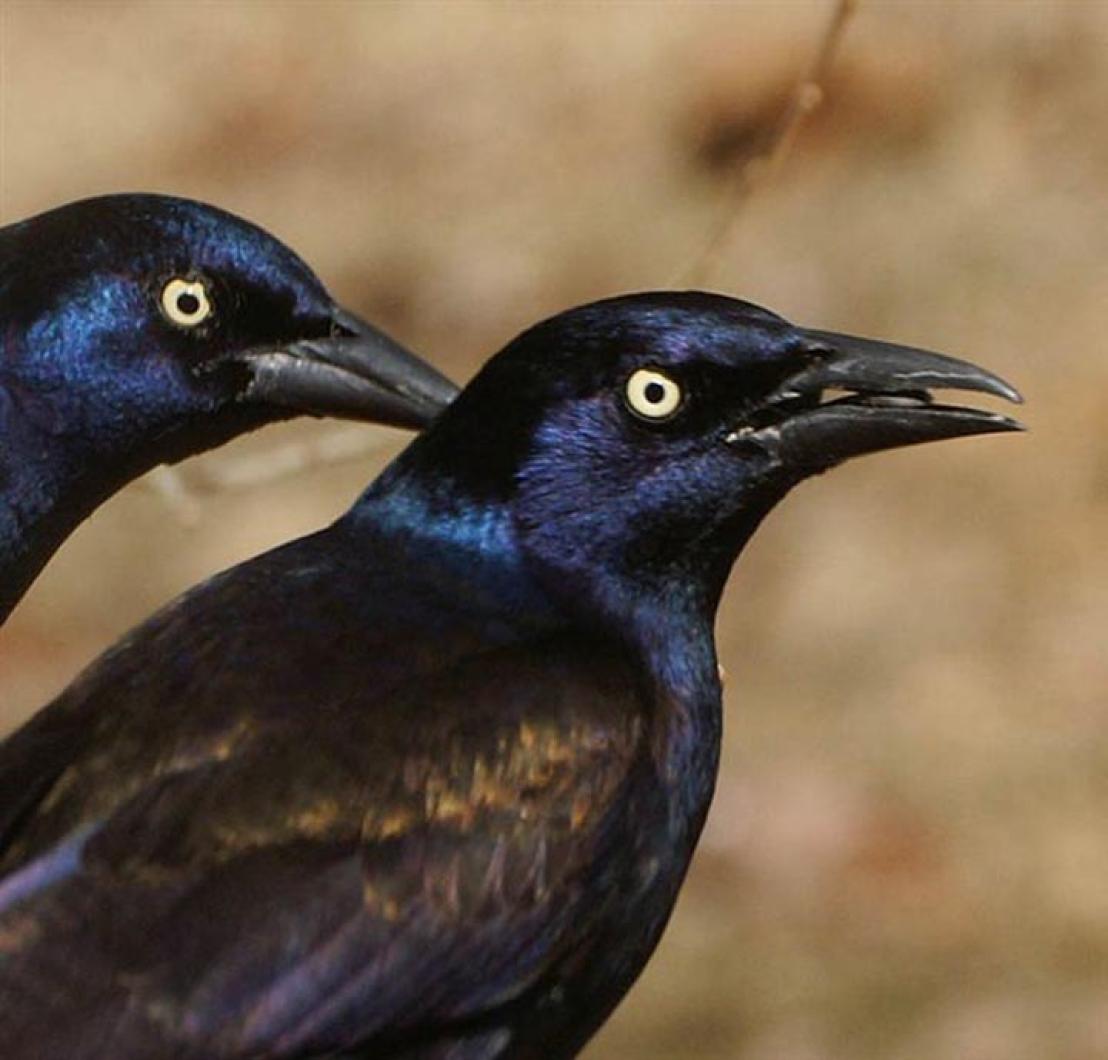Crow blackbirds have arrived on Island. They run and hop around the yard and fields holding their head and keel-shaped tails high. In the right light the feathers on their heads and necks are an iridescent purple-blue and their backs bronzy. I am used to these common grackles arriving around St. Patrick’s Day or the Ides of March. The grackles have a different idea.
The male common grackles arrive first. They make a sound like a rusty/creaky gate or a “chuck” call as they prance around the feeders. About two weeks later a duller, smaller version shows up: the female common grackle. The males indulge themselves in quite a display to attract mates. They raise their shoulders, spread their wings and puff up their feathers and make a deep bow. I have seen two males displaying to each other, perhaps to practice or perhaps because they think a female is close at hand.
The female grackle builds the nest, which is constructed of weeds and grasses mixed with seaweed and sometimes glued together with mud. It is about three inches deep and six inches high. The female crow blackbird lays four or five eggs, which can be greenish to light rusty brown and always mottled with brown and purple splotches. The nests are located in a variety of plants, including cedar trees, tall pines and spruces, and cattails. Both parents incubate for two weeks.
The young grackles are your basic brown. They feed on seeds, insects and, later in the season, fruits and berries. Adult crow blackbirds have a reputation for stealing eggs and young from other bird’s nests. The common grackle may be a rogue, but watching its behavior is a treat.
Bird Sightings
The hot news this week is the appearance of American oystercatchers. Scott Stephens and Roger Cook tied for first place. Scott spotted his oystercatcher near Maciel Marine in the Lagoon on March 6. The same day Roger saw his oystercatcher on Sengekontacket Pond shore. Not sure who saw theirs first. This may be the same bird. The earliest record for American oystercatchers in the past is Feb. 28 — these sightings are close!
Barn owls are moving about. Bert Fischer spotted one perched on a fence post at the Allen Farm in Chilmark on March 3. Woody Bowman watched a barn owl fly across the Panhandle field in West Tisbury, light in a shrub near his house and then fly off back across the field on March 1.
Gus Ben David noted that the Eastern bluebirds that have been around the World of Reptiles and Birds have started checking out his nesting boxes. Woody Bowman counted eight eastern bluebirds landing in a tree in the Martha’s Vineyard Airport parking lot on March 2. Suzie Bowman called to say the Eastern towhees at Felix Neck are becoming quite vocal.
Rob Culbert had a flock of 15 cedar waxwings and five eastern bluebirds and 50 red-winged blackbirds arrive in his Tisbury yard to feed on the crab apples left on his tree on Feb. 26. On Feb. 28 Rob, his wife, Wendy, and Margaret Curtin counted five Northern gannets from the SSA dock in Vineyard Haven.
Chris Murphy called to report that two pair of green-winged teal arrived on his Middle Road pond on March 1. This, Chris feels, is early for green-winged teal migration. I agree. Usually in the past these teal didn’t arrive until late March. Things are changing!
Luanne Johnson spotted a drake green-winged teal in a pond near the Blackwater and Ripley Field Preserves on Feb. 29. It is not clear whether this is a winter resident or a migrant.
Andrea Hartman took a little walk around the two big fields by the Quenames house and barn in Chilmark on Feb. 29 and saw at least four Eastern meadowlarks in with a small flock of red-winged blackbirds feeding in the grasses.
Nancy Rogers heard an American woodcock near her Tisbury home on March 5. Ken Magnuson sent me three photos he took on March 4, one of a red-necked grebe by the Memorial Warf in Edgartown, one of ring-necked ducks at the Vineyard Golf Club, and one of a black-bellied plover at Katama.
Rob Bierregaard has updated the osprey pages on his Web sitem bioweb.uncc.edu/bierregaard/migration11.htm. Rob figures that Belle will head north in March or April, but he is concerned about Snowy, who has settled in Venezuela close to what looks like a fish farm. Fish farmers don’t cotton to fish predators. We will keep our fingers crossed that he escapes.
Please report bird sightings to the Martha’s Vineyard Bird Hotline at 508-645-2913 or birds@mvgazette.com. Susan B. Whiting is the coauthor of Vineyard Birds and Vineyard Birds II. Her Web site is vineyardbirds2.com.





Comments (2)
Comments
Comment policy »